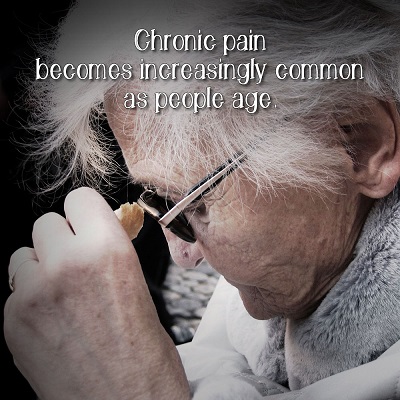 Chronic pain is one of the most common conditions suffered by elderly people. It is pain that continues long beyond an expected period. To make matters worse, chronic pain becomes increasingly common as people age.
Chronic pain is one of the most common conditions suffered by elderly people. It is pain that continues long beyond an expected period. To make matters worse, chronic pain becomes increasingly common as people age.
It’s one of the concerns and questions for many people as they age – Will I have to live with chronic pain when I get older, and every day until I die? Will I be able to do anything about it so that I can live a pain-free existence? Do I have to take medications when I don’t want to? All these questions can cause a senior person to worry about their future mobility, and ability to enjoy their life.
Several conditions can likely put a senior at risk of developing chronic pain, and for those seniors already experiencing chronic pain, it may be due to any of the following conditions:
- Cardiovascular Diseases
- Neurologic Diseases
- Diabetes Mellitus
- Arthritis
- Cancer
- Renal Diseases
- Congestive Heart Failure
- Pulmonary Obstructions
- Joint or Skeletal Injuries or Surgeries
- Fractures
The truth is that many seniors are enduring chronic pain in silence.
Here are the possible reasons why some seniors tend to ignore and under-report their chronic pain symptoms:
- The assumption that it is a natural part of aging.
- The fear of submitting themselves to several medical examinations.
- The fear of prescribed medications.
- Seniors whose chronic pain is known to be associated with a particular disease are scared to know about the prognosis of further disease or escalation of it.
Addressing Chronic Pain In the Elderly
Chronic pain must not be dealt with passively. In many cases, a responsible person in the family may have to step in and help with their pain management. They can help organize multiple treatment and pain management plans.
Addressing the type of chronic pain and discomfort suffered may not be possible immediately, and it may take multiple health care providers to assess the condition and bring correct guidance to the situation.
Here are some guidelines on how to help manage chronic pain in seniors.
Assess the Level of Pain
Let’s start at the very beginning, by assessing the level of pain and discomfort the elderly person is experiencing. This doesn’t happen without any challenges. Accurately evaluating the level of pain may not always be possible.
This is because some elderly people will either downplay their situation due to various fears, or they may be someone who cannot accurately give you an answer because of cognitive decline or other similar conditions.
If they can answer you effectively, the simplest method of doing this is by asking them to describe their pain using a descriptive scale, for example, ‘describe your pain on a scale of 1 to 10, with 10 being the highest.’
Observe the Afflicted Senior for Their Reactions
Don’t stop at asking the person for their evaluation, but make sure to continually observe them for non-verbal cues and other reactions. They might be feeling worse than they can describe, or more than they’re willing to let on.
Managing Pain Through Medicines
Using medicine to treat pain is often very effective, but this should always be done by their physician. Some people may not believe in prescription medication and that’s ok. They can be helped by a naturopath or holistic health care professional. Whatever treatment they feel comfortable with is the pain management plan they should be using.
Nonpharmacologic Pain Management
As just mentioned above, there are numerous nonpharmacologic strategies for managing chronic pain in seniors. Some seniors may prefer alternative treatment methods, for example, physical therapy, massage therapy, Bowen therapy, hot and cold therapy, acupuncture, chiropractic and more.
Suffering from chronic pain is a major concern for seniors, and for good reason. No one wants to live a life of pain every day. Therefore, finding the appropriate pain management treatment plan that suits their needs and beliefs is super important, if they are to live a pain-free existence.






